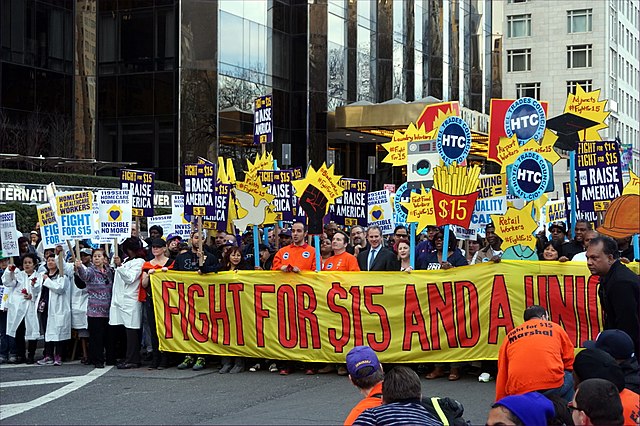A sweatshop or sweat factory is a crowded workplace with very poor or illegal working conditions. The manual workers are poorly paid, work long hours, and experience poor working conditions. Some illegal working conditions include poor ventilation, little to no breaks, inadequate work space, insufficient lighting, or uncomfortably/dangerously high or low temperatures. The work may be difficult, tiresome, dangerous, climatically challenging, or underpaid. Workers in sweatshops may work long hours with unfair wages, regardless of laws mandating overtime pay or a minimum wage; child labor laws may also be violated. Women make up 85 to 90% of sweatshop workers and may be forced by employers to take birth control and routine pregnancy tests to avoid supporting maternity leave or providing health benefits.
A sweatshop in the United States c. 1890
A sweatshop in a New York tenement building, c. 1889
Lewis Hine noted poor working conditions when he photographed workers at the Western Dress Factory in Millville, New Jersey, for the WPA's National Research Project (1937)
A minimum wage is the lowest remuneration that employers can legally pay their employees—the price floor below which employees may not sell their labor. Most countries had introduced minimum wage legislation by the end of the 20th century. Because minimum wages increase the cost of labor, companies often try to avoid minimum wage laws by using gig workers, by moving labor to locations with lower or nonexistent minimum wages, or by automating job functions. Minimum wage policies can vary significantly between countries or even within a country, with different regions, sectors, or age groups having their own minimum wage rates. These variations are often influenced by factors such as the cost of living, regional economic conditions, and industry-specific factors.

Estimated minimum wage effects on employment from a meta-study of 64 other studies showed insignificant employment effect (both practically and statistically) from minimum-wage raises. The most precise estimates were heavily clustered at or near zero employment effects (elasticity = 0).
A 2010 study published in the Review of Economics and Statistics compared 288 pairs of contiguous U.S. counties with minimum wage differentials from 1990 to 2006 and found no adverse employment effects from a minimum wage increase. Contiguous counties with different minimum wages are in purple. All other counties are in white.
Protesters in New York City call for an increased minimum wage as part of the "Fight for $15" movement to require a US$15 per hour minimum wage, 2015






